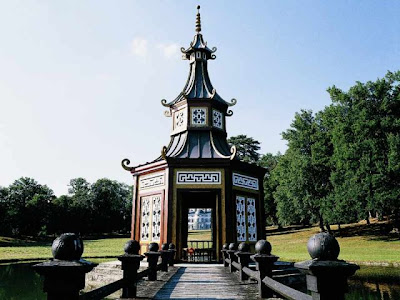The gardens at Chateau de Groussay are just as amazing as the main house. Charles de Beistegui was inspired by 18th-century Anglo-Chinese parks and gardens and created many "follies" to surprise and delight his guests.
The most famous is the Tente Tartare that was built in 1960. It was inspired by the tent that King Gustav III of Sweden raised in Drottningholm.
The exterior is painted wood and not really a tent.
The interior is completely clad in Delft tiles that must be amazing to behold in person.
The Chinese Pagoda was found in Rome by Emilio Terry in 1968. The pond and island were created specially for the Pagoda.
Pagoda interior.
All of the follies are just as beautiful inside as out.
The Palladian Bridge was designed by Emilio Terry in 1960. It recalls the bridge at Wilton Park in England and the Guglie Bridge in Venice where Charles de Beistegui owned his famous Palazzo Labia.
The Column Observatory was inspired by the Vendome column in Paris and was built in 1962. You can view the entire countryside from the top.
The Temple of the Labyrinth sits at the center of a small maze and was built in 1967.
Garden photos from Alan Rosenberg

























No comments:
Post a Comment